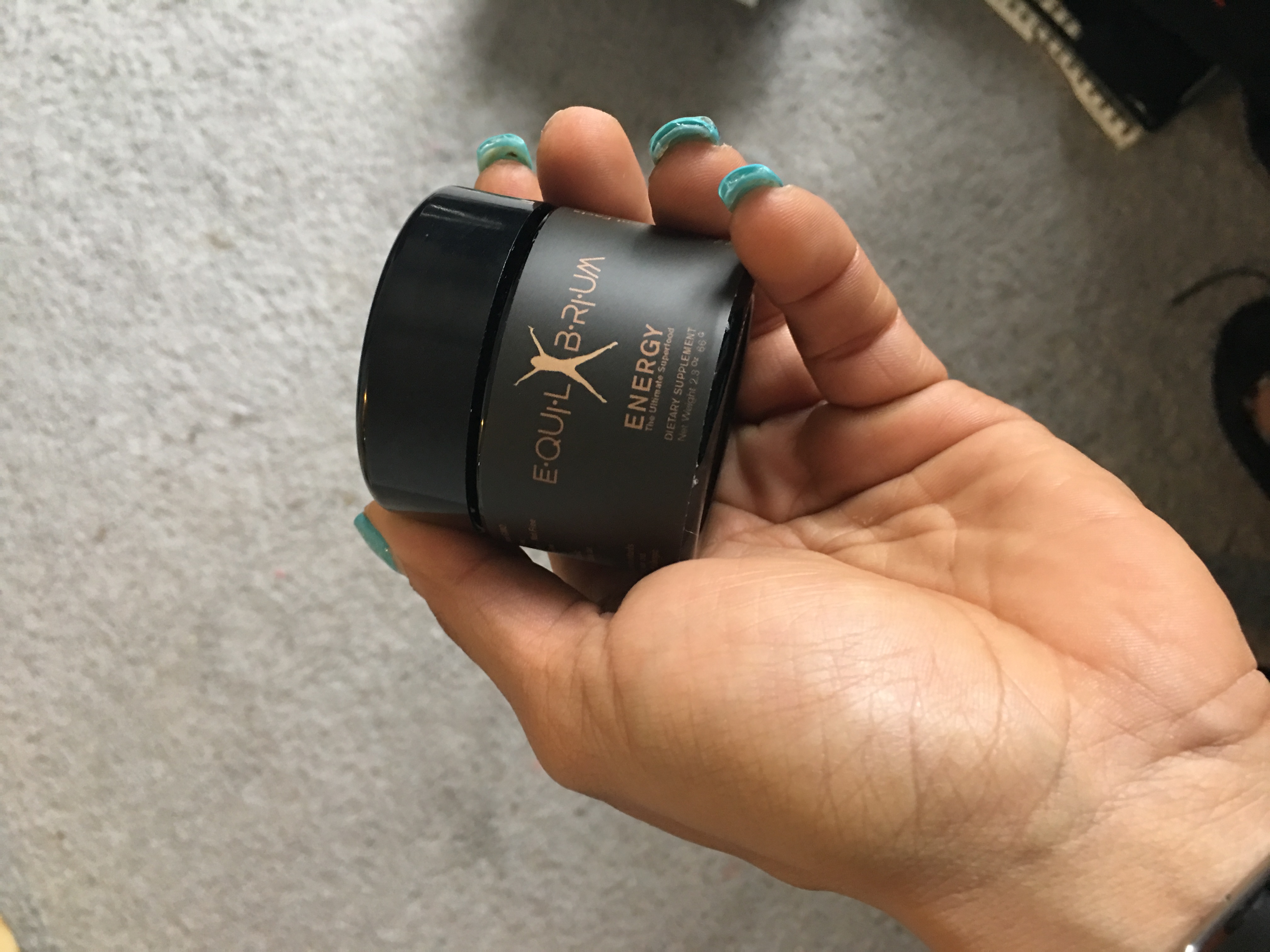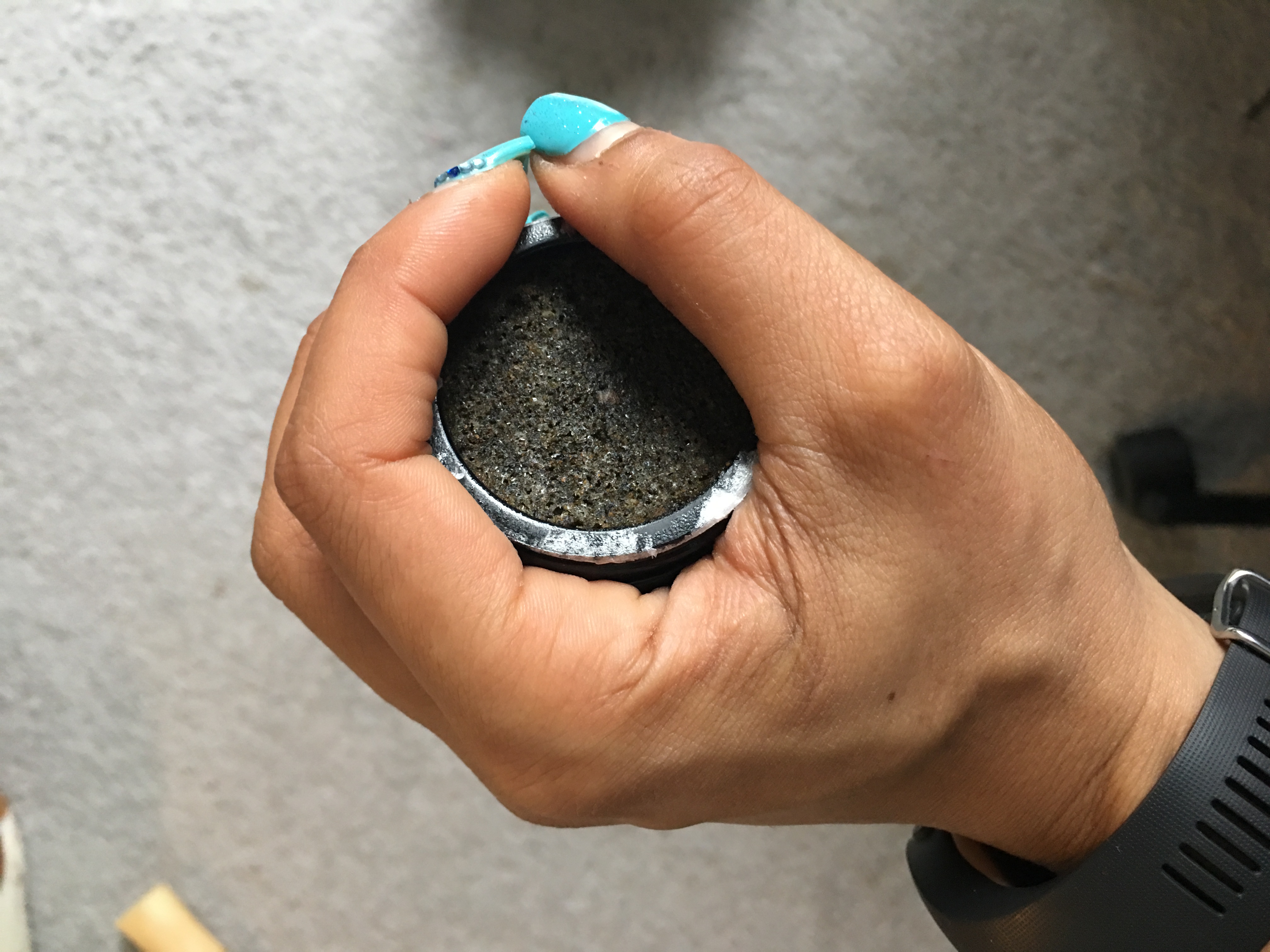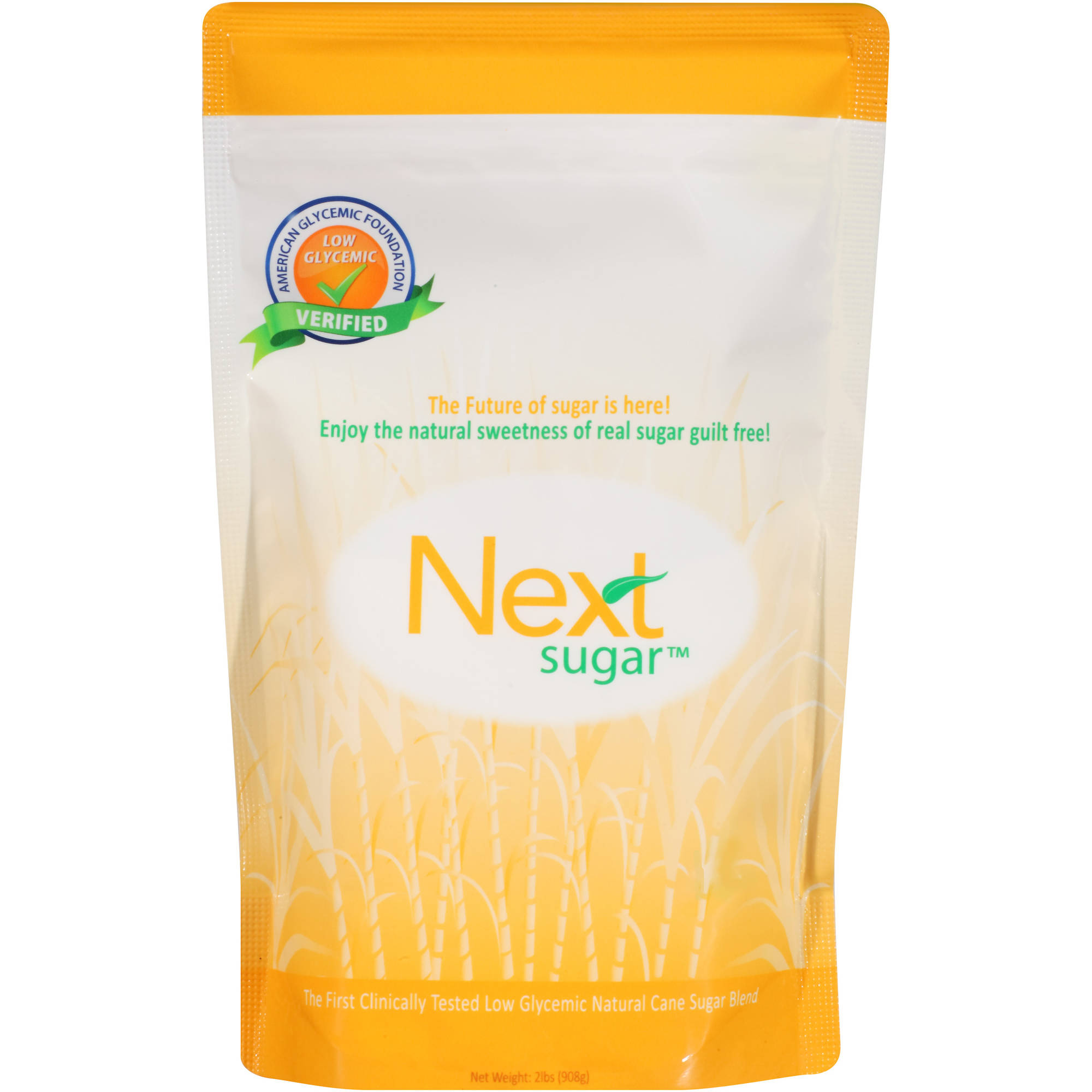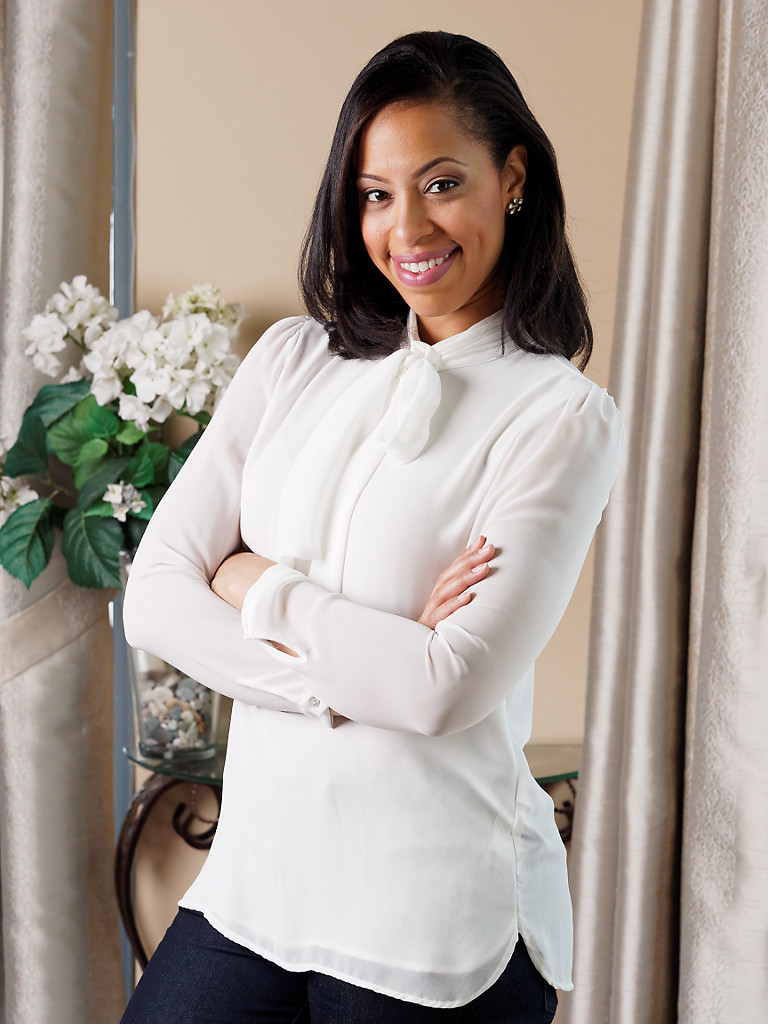Hey Guys!

Equilibrium Superfood 12 Ounce
Equilibrium Superfood 2.3 Ounce
Happy Holidays! I want to share with you my review of a new product that I was sent! Its called Equilibrium! As you know I promote fitness and health and I tell you all my opinions on products and supplements so this is no different. I tried it. I love it. And I want to share it with you guys!

(DONT JUDGE MY NAILS - I need a manicure)
What is it? Equilibrium is the evolution peak of superfoods. The company that creates it is called HoneyColony. They have created and formulated raw honey-based blend consists of organic and wildcrafted ingredients. To create their specific blend, they actually teamed up with former Bee Panacea formulator, Gosia Reed.
About the product: At the core of Equilibrium is raw honey. Eleven other potent superfoods are added—each one organic or wildcrafted, boasting numerous health benefits. The total 12 ingredients bring harmony to a life that faces any stress, toxins, and negative energy.

How its made: Equilibirum Superfood is made in small batches to ensure high quality, exact measurements, and consistency in every jar. To ensure our product never loses integrity, we use high-quality Biophotonic jars that only let sunlight in to improve the substances in each formula.
Equilibrium comes in three different flavors and offers three different functions. The first one, Energy, was designed for athletes or anyone who lives an active lifestyle. This is the one that they sent me. It works by naturally stimulating the nervous system, enhancing brain function, supporting muscle relief, and providing anti-inflammation support, each jar will keep you in the active zone. For those of us who who seize life in its whirlwind of activity, Equilibrium Energy offers the support you need for a mental and physical edge.

My experience: Because they sent it to me at the end of my prep for my figure show I was unable to try it right away. When I won my competition and my diet became more flexible I was able to introduce it! I decided to take a spoonful every morning as they recommended. Because I was reducing my stimulants from prep I found it very helpful with increasing my energy On top of this it was very delicious! I looked forward to taking it because it was like a nice sweet treat!
Things to know: If you count your macros or calories. Equilibrium is 25 calories per serving, 5g of carbohydrates and 3g of sugars!
I would highly recommend this if you are looking for a natural energy enhancer as an athlete or fitness enthusiast! And if you are a macro tracker during prep you may want to wait until you're off of prep.
Purchase them here:
Equilibrium Superfood 12 Ounce
Equilibrium Superfood 2.3 Ounce
For more information or to see their other products please check out their website https://www.honeycolony.com
Pain Relieving VibraCool® Debuts During Walt Disney World Marathon Weekend
Makers of Buzzy® Needle Pain Relief to attend runDisney Health and Fitness Expo for product demonstrations and sales
MMJ Labs, LLC, industry leaders in non-invasive pain relief, will debut their newest product, VibraCool® Massaging Ice Therapy, at the runDisney Health and Fitness Expo in Orlando, Fla. VibraCool® is the wearable pain therapy device that provides simple, serious relief for IT Band pain, carpal tunnel, tennis elbow, and other painful overuse conditions and injuries. Expo attendees will have the opportunity to experience the instant pain therapy of VibraCool® at the booth throughout the event. Runners will be able to purchase the product for use on pre- and post-race aches and pains -- and beyond. Product demonstrations, raffles and sales will take place in Booth 605 in the Stadium Exhibition area during expo hours from January 4-7, 2017.
Team members will be interacting with attendees to help them find the VibraCool® model that best fits their needs. The innovative pain relief product is offered in three configurations to treat areas where pain is common: Plantar Fasciitis/Neck/Shoulder, Wrist/Elbow, and Knee/Ankle.
VibraCool®’s Cool-Pulse™ technology is what makes it so effective for runners of all levels -- from 5k first-timers to Dopey Challenge takers. One push of a button leverages the physiologic pain relievers of high frequency massage and ice in a product optimized for athletes and chronic joint pain sufferers. VibraCool®’s intense 20-minute frozen solid ice packs decrease inflammation, pain and swelling. Vibration massages muscles, mechanically loosening stiffness and improving blood flow. For post-workout aching, using VibraCool’s massaging alone before a workout can prevent delayed onset muscle soreness. The design also features a neoprene compression strap so VibraCool® can move with you during therapy or recovery.
Make the VibraCool booth your go-to stop at the Expo for pre-race muscle prep and post-race recovery. To learn more about VibraCool®, visit www.VibraCool.com, or the needle product line Buzzy® and DistrACTION® cards at www.buzzyhelps.com. Engage in conversations about pain relief with VibraCool on Facebook, Twitter and Instagram.
Hydroxycut®, America's #1 selling weight loss supplement brand, is evolving by developing new support programs to help consumers stay on track this New Year. The brand is introducing a new, free weight loss app designed and developed based on key insights from a recent study conducted on American's views of New Year's Resolutions.
When January 1st arrives, Americans will be rushing to fitness centers the next day and re-evaluating their fitness goals. The study revealed that 56% of Americans would make New Year's Resolutions specifically about adopting a healthier lifestyle, however within the first week, six million people will have already broken those commitments. The study documented that the struggle of losing weight continues to remain the number one resolution and also showed that people believe it is also the most challenging one to keep.
"When we embarked on this unique study, we wanted a deeper understanding of the mindset and challenges American's have when making the important decision to adopt a New Year's Resolution that focuses on supporting a healthy lifestyle through weight management," Chief Marketing Officer, Brian Cavanaugh stated. "The results of our study prompted our consumer insights team to design and launch an easy-to-use, free app that will help people making healthier lifestyle changes easier so people can stay on track for the long term."
The simple but effective app offers users the opportunity to monitor their weight loss results with convenient meal tracking, supplement reminders and a simple to understand exercise plan. Throughout the weight loss journey, individuals can face challenges in meeting proper nutritional intake levels, proper hydration, and exercising regularly, all of which can influence weight loss success. The new Hydroxycut app minimizes the challenges associated with everyday diet programs by holistically supporting a more comprehensive approach, tailored to meet the needs of men and women, regardless of their fitness levels.
For more information and how to download the new weight loss App, simply search Hydroxycut on Apple or the Google Play Store. For full study results please go to www.Hydroxycut.com/NewYearStudy and follow us on Facebook.com/Hydroxycut and @Hydroxycut on Instagram® for product, news and updates, diet and training tips, special promotions and more.
Hydroxycut has sold more than 100 million bottles and continues to be a nutritional supplement leader by bringing unique and innovative products to consumers who want to change their lives. For more than two decades, the brand has been successfully inspiring and empowering weight loss for people who want real results. Hydroxycut products are available nationwide at WalMart®, Target, Walgreens, CVS, Rite Aid, GNC, Vitamin Shoppe, Amazon, Bodybuilding.com and other fine retailers.
About Iovate Health Sciences International Inc.
Iovate Health Sciences is a dynamic, leading-edge nutritional supplement company that delivers some of the highest quality, most innovative and effective supplements in the world. Iovate brands are sold in over 130 countries globally, and include the sport and active nutrition brands MuscleTech®, Six Star® Pro Nutrition and Purely Inspired®.
SOURCE Iovate Health Sciences International Inc.
Let Them Eat Wheat! Using Ancient Wisdom/Modern Science to Overcome Food Intolerances - Book Review

I was recently sent a book by Dr. Jon dullard to review. The title of the book was Eat Wheat - A scientific AND Clinically-Proven approach TO Safely Bringing Wheat AND Dairy Back INTO your diet.
What I loved about the book: Its based on scientific facts that he has used with thousands of patients to help them cure their food intolerances. This book is a real eye opener and a must read for fitness and health enthusiasts or anyone that has dietary issues/intolerances. Its great also because it is evidence based.
I also enjoyed that he discussed the underlying cause of the gluten-free explosion. And that he goes on to discuss that when you eliminate wheat and dairy fro your diet it may illuminate your symptoms but it may also be a temporary solution.
This book is also a great read because it helps you learn how to navigate around food toxins in modern what and dairy and reveal the hidden science on the benefits of wheat and dairy. Through this he helps you see that you can retrain your body to digest wheat and dairy again. These things are very applicable for health but for bodybuilding and aesthetics it does not 100% apply in my opinion.
Has gluten been found guilty without a fair trial? It wouldn't be the first time an innocent food was given a life sentence. For example, after almost 60 years of so-called "hard science" condemning cholesterol, we now find out that the science was flawed and high cholesterol saturated fats, such as butter, have been officially taken off the FDA's nutrient concern list. Is it possible that we have wrongfully given gluten the boot as well? Turns out, if you’re gluten-free or dairy-free, you might not have to be!
Eat Wheat: A Scientific and Clinically-Proven Approach to Safely Bringing Wheat and Dairy Back into Your Diet (Morgan James, January 2017) by Dr. John Douillard, DC, CAP, addresses this timely topic of food intolerances. After 3.4 million years of eating wheat and only 500,000 years of hunting meat, through Eat Wheat, Dr. Douillard reminds us that humans are actually genetically better equipped to eat wheat than meat and the true Paleo diet, clearly, included glutinous grains like wheat and barley.Dr. Douillard is a former NBA nutrition expert and creator of LifeSpa.com.
He has spent the past 30 years and has seen more than 100,000 patients in his natural health practice, helping to improve their digestive systems and begin to eat wheat again.“The most common dietary advice doctors have been giving their ailing patients for the past 30 years is to stop eating wheat and dairy,” says Dr. Douillard. “It’s just not that easy. Helping folks navigate around the processed versions of wheat while rebooting the digestive system is simply absent in medical practice, while being gluten-free has become a movement. We are fooling ourselves to think that all of our problems will disappear by just avoiding wheat. For years, I’ve seen patients after they have stopped eating wheat and dairy, and while they almost always feel better initially, the symptoms all too often return, leaving them with hardly anything to eat. With Eat Wheat, we can do better.”
Eat Wheat presents the science on the other side of the gluten-free aisle. For example, ancient wheat has been shown to have twice the gluten content of modern wheat yet decreased inflammation two-fold and lowered cholesterol and blood sugar.
So how could the more glutinous grain actually be healthier? In addition, wheat was a fall harvested grain that humans are well adapted to eating. Wheat digesting enzymes and microbes proliferate in the fall and winter to break down this so-called poison, gluten. So what is the real cause of America’s gluten sensitivity?
Eat Wheat explains how a breakdown in digestion has damaged the intestinal wall and leaked undigested foods and environmental toxins into the body’s lymphatic system, causing “grain brain” symptoms and food allergies. Although eliminating wheat and dairy from your diet may help your symptoms, it’s a temporary solution. The book addresses the root cause: the inability to digest well and break down harmful pollutants and toxins that can lead to more serious health concerns.Backed by more than 600 scientific studies, Eat Wheat is a revolutionary guidebook to regaining your digestive strength and safely bringing wheat and dairy back into your diet. It will also:
- Reveal hidden science on the benefits of wheat and dairy
- Help you navigate around food toxins in modern wheat and dairy
- Detail how to flush congested lymphatics linked to food intolerance symptoms
- Teach you to follow natural digestive circadian cycles
- Help bring your blood sugar back into balance
- Teach you proven exercise and detox techniques to reboot strong digestion and achieve optimal health and vitality
“Your digestive strength is the key to a long, healthy and vital life,” adds Dr. Douillard. “The choice as to whether or not you can eat gluten or dairy shouldn’t be decided for you because of weak digestion, it should be decided by you as a preference.”
Dr. John Douillard, DC, CAP, is a globally recognized leader in the fields of natural health, Ayurveda and sports medicine. Over the past 30 years, he’s helped over 100,000 patients repair their digestive system and eat wheat and dairy again. He is the creator of LifeSpa.com, a leading Ayurvedic health and wellness resource on the web with over 4.5 million views on YouTube. LifeSpa.com is evolving the way Ayurveda is understood around the world, with over 700 articles and videos proving ancient wisdom backed by modern science. Dr. John is the former Director of Player Development and nutrition advisor for the New Jersey Nets NBA team, author of six books, a repeat guest on the Dr. Oz show, and has been featured in Woman’s World Magazine, Yoga Journal, the Huffington Post and dozens of other publications.
For more information, please visit www.eatwheatbook.com,www.lifespa.com, and connect with Dr. Douillard on Twitter, Facebook and YouTube.
Eat Wheat will be released in ebook form on September 1, 2016, and in paperback and hardcover on January 10, 2017. It can be pre-ordered from Amazon, Eat Wheat Book and all major booksellers.
Walk or run your way to a smoke-free life
With the holiday season here, you may be thinking about New Year’s resolutions.
Whether your motivation is to get healthy or save money, to quit smoking for a loved one or for yourself, the important thing is to make the decision to quit.
Gary started smoking when he was just 13. Like many people, his annual New Year’s resolution was to quit smoking. And in 2016, he finally did it. How? By joining Run to Quit.
You may be thinking “I’m not a runner,” but Run to Quit is an innovative quit-smoking program that pairs the quitting expertise of the Canadian Cancer Society with Running
Room Canada’s Learn to Walk or Run 5 km clinics. And it offers cash prize incentives to remain smoke-free.
The step-by-step program has been shown to help smokers cope with discomfort and cravings through its simple and encouraging approach to cutting down and getting active.
Because Gary had quit before and then relapsed after having “just one” cigarette, he made a game plan to stay away from cigarettes until he was over the cravings.
For his strategy to work he had to change routines, such as not going outside with his colleagues for smoke breaks. “Instead, I would walk around the block or do something else.”
He used other tactics to become tobacco-free, including tracking his savings of $20 a week, which meant extra tickets to sporting events. Winning $1000 from Run to Quit was an added bonus.
Now Gary’s success is inspiring others to quit too. “I’ve talked to people at work and they’re going to join Run to Quit and make it part of their New Year’s resolutions this year.”
Available across Canada. For more information or to register visit runtoquit.com
Next Sugar - Review
Some Nutrition facts:
Per packet (3g)
Calories 6
Carbs 3g
What is it you ask? Next Sugar is the first clinically tested, low glycemic natural cane sugar blend that tastes just like sugar because it is real sugar. Their unique blend naturally and safely blocks up to 50% of the sugar from being absorbed by the body. Less sugar absorbed, means less calories.
It tastes pretty good compared to sweetners. It doesn't have that aspartame taste. Im not too sure how much I would use it when I am in prep based on the fact it is still sugar. However I will put it to use in my off season!
If you want to try check them out at: http://next-sugar.com
A little bit more info:
Big Sugar is a BIG Problem!
Around the world, hundreds of millions of people need to reduce their sugar intake -- from individuals who need to manage their weight, to diabetics who must carefully control their blood sugar levels.
At the same time, people who are currently healthy must be on alert, too. Studies show that over-consumption of sugar can trigger a range of serious metabolic syndromes like heart disease. It can also lead to obesity, which is now an epidemic crisis -- especially among children. In short: big sugar is a BIG problem!
Sugar Substitute? Not a Chance!
However, so-called “sugar substitutes” are the problem -- not the solution! In addition to tasting nothing like real sugar, these products are loaded with chemicals, and can actually trigger weight gain and cause adverse health issues.
The good news is that there’s a new sugar alternative on the market that is finally delivering the solution that so many people -- including health researchers and medical professionals -- have been waiting for: NEXT SUGAR.
Benefits Backed by Clinical Trials
NEXT SUGAR is the world’s first low glycemic, non-GMO and Kosher natural cane sugar that has a sweetness intensity and profile of conventional sugar, but with a groundbreaking advantage: its unique composition naturally and safely blocks up to 50% of the sugar from being absorbed by the body. NEXT SUGAR is suitable for any traditional use of sugar, such as baking, cooking and sweetening.
What’s more, NEXT SUGAR’s advantages are not based on hyped-up marketing claims. They are backed by successful human clinical trials, such as one by Sydney University’s “Glycemic Index Research Service” (SUGiRS) which concluded that: “NEXT SUGAR would be suitable for consumption in controlled amounts by people with diabetes in line with their individual dietary requirements.”

Positive Thinking Will Never Change Your Life...But this Book Will - A book review
If the title doesn't get you Im not sure what will! I am always looking for positive and uplifting books to learn tips and tricks from. And this book really hit the nail on the head. It puts the myth of positive thinking to the test and really gets into the reality of success.
The author is a man named David Essel, M.S. is the author of 9 books, a Master Life Coach and Teacher, Business Relationship and Addiction recovery Coach, International Speaker and Radio/TV Host (what doesn't this guy do?) For more info on him check out: www.davidessel.com
I really enjoyed this book and if you are looking for a more positive 2017 definitely pick it up, I highly recommend it! It was an easy read and definitely a great way to start off your 2017!


Happy Holidays!
The holidays here! And before we know it, we’ll be ringing in 2017! I know most of us are all already thinking of training hard to make up for all of the holiday treats. However training hard can be dangerous. Make sure before you jump into an intense training routine that you are cleared by a doctor to exercise, are wearing the proper workout gear and know how to train hard safely. You’re especially prone to injury when you’re training hard.
I recently had the opportunity to sit down and speak with chiropractor Nekessa S. Remy. Dr. Remy is based in downtown Toronto at the Integra Health Clinic. I got to ask her questions regarding how to prevent injuries when training hard. So, if you are about to embark on a fitness journey check out what we spoke about below:
Alicia: When training with an all-out effort, do you suggest a dynamic or static stretching routine?
Dr. Remy: For any workout routine, the most important factor for stretching is knowing when to perform each stretch; both types of stretching are important. Dynamic stretching consists of functional based exercises, which use specific movements to prepare the body for movement. This involves moving parts of your body and gradually increasing reach, speed of movement, or both, while increasing your core temperature. This type of stretching is best used before your workout as part of a warm up. We know that a proper warm up can not only affect the likelihood of injury, but also directly impacts your ability to perform to your maximum ability. As such, dynamic stretching plays a major role in maximizing your performance levels and should be a key part of any warm up
- Like dynamic stretching, static stretching improves flexibility by moving joints through a specific range of motion. However, unlike dynamic stretching, it does not increase your core temperature. These stretches are often held for longer periods, ideally 20 to 30 seconds. Static stretching suppresses the central nervous system, relaxing the muscle spindles by lengthening them, and has been shown to actually reduce power and force production in several studies. This type of stretching is more effective during the cool down period of your workout.
A: What are some stretches that should be included in a routine?
Dr. R: Flexibility is often overlooked as part of a heavy training routine. Consider the amount of time we spend siting behind a computer desk when not training, sitting watching tv or sitting behind in a car. These postures keep our joints in very restrictive positions. I recommend addressing the areas which are most restricted including the hips, shoulders and lower back. Some of my favourite stretches include:
Pigeon Stretch (Hips)
- From Downward Facing Dog, step both feet together and bring your right knee forward between your hands so your outer right leg is resting on the mat.
- If your hips are more open, inch your right foot away from you. Make sure your left hip is always pointing down toward the mat. If it begins open up toward the ceiling, draw your right foot back in toward your body.
- Stay here with your hands resting on your right leg or walk your hands out in front of you, allowing your torso to rest over your right knee.
- Hold here, breathing into any areas of tightness and tension for at least five breaths.
Then place your hands on the mat in front of you, tuck your left toes and step your right foot back.
Repeat using the left leg.
Cow’s Face (Shoulders)
- Stand with your feet hip-width apart and pointed straight ahead.
- Attempt to interlock your fingers behind your back. If you are not able to get your fingers to interlock, use a towel.
Hold for one minute, then switch sides and repeat.
Knee rolling (lower back)
- Lie on your back as above with the knees bent.
- Slowly lower both knees to the left whilst turning the head to the right.
- Bring the knees up again and to the right whilst looking left.
- Repeat this movement 10 times.
A: How often should someone train hard to achieve maximum results?
Dr. R: You can train anywhere from 3-7 days a week. The important thing is to incorporate cross training into your program. So whatever discipline you are training in, keep in mind that you are often working specific muscle groups repeatedly and ignoring others. Cross training on your “days off” can help to address muscle imbalances that can occur when focusing on only one activity. Cross training not only aids in reducing the occurrence of injury, but also allowing for maximum gains.
In general, you want to give your body 24-48 hours in between really hard training sessions. Within those 24-48 hours, you don’t have to be inactive, though; try an activity that will not hinder your training. Pilates, yoga and swimming are all great choices that will allow your body to remove while continuing to build supporting muscle strength which can ultimately also improve your performance.
A: When should you back off from training hard?
Dr. R: The biggest sign that you should back off from training is pain and/or injury. Pain is a sign that there is an issue with your body. Keep in mind that most lifters do experience delayed onset muscles soreness or DOMS, as its often called. This soreness is the result of microscopic damage to muscle fibres involved in the exercise. This type of damage likely results from moderate stresses that were experienced during the exercise. This is a normal process which is required for growth in muscle size and strength. It will start approximately 24 hours after the workout but should be gone after 72 hours. If pain persists, there is most likely an injury. Training when injured not only will limit your body’s ability to recover from that specific injury but the compensation that occurs in other areas of the body can lead to other injuries occurring simultaneously.
A: Does hydration play a factor in your ability to train hard and stay injury free?
Dr. R: Water composes 75% of our muscle tissue. A study published in the “Journal of Strength and Conditioning Research” reported that a 1.5 percent decrease in water loss resulted in a decrease of muscle strength of the one rep max bench press. Given that such a small amount of water loss can compromise strength, staying hydrated is essential in muscle strength and gain. Researchers found that the amount of water within cells plays a critical part in whether or not muscle breakdown occurs. Preventing muscle breakdown is crucial since muscle breakdown stops muscle growth within muscle cells. Decreased body water leads to the shrinkage of cells and the breakdown of protein. Thus, by maintaining adequate fluid levels, we can cause cells to swell, thereby reducing the amount of protein breakdown and increasing the building of new muscle tissue which will ultimately improve strength gains and reduce muscle injury. Further more, dehydration causes our blood volume levels to drop which causes fatigue and dizziness. Training when fatigued will both hinder training and increase the risk of injury.
As a general rule of thumb, you should be taking in 1 Litre of water per 1,000 calories expended per day. So someone who burns 2,500cals would drink 2.5 Litre fluid daily.
A: How much water should you be drinking if you are training hard?
Dr. R: The amount of water a person should consume daily is a controversial subject. The standard eight glasses of water a day prescriptions recommended all over the place won’t be enough for serious muscle seekers. This is fine for the average person who consumes around 2,000cals a day without much activity. However, if your workouts are frequent and intense, you will require more water.
As a general rule of thumb, you should be taking in 1 Litre of water per 1,000 calories expended per day. So someone who burns 2,500 cals should drink 2.5 litres of fluid daily.
A: What should my nutrition look like before and after a workout?
Dr. R: By eating a healthy, well-balanced meal one to two hours before exercise, and another health, well-balanced meal within one to two hours after exercise, most people can meet their workout nutrition needs without anything else.
Pre workout Meal:
If you’re looking to increased strength gains, your protein and calorie needs are likely higher. Keep in mind that calories from carbs should come from carbs that are low on the glycemic index. You could also add a protein + carbohydrate drink during your training. A typical meal could include:
1 to 1 ½ servings of dense protein (i.e. lean meats)
1-2 portions (thumb size) of healthy fats (i.e. nuts)
1-2 servings (fist size) of vegetables (broccoli, cauliflower)
1-2 handfuls of dense carbs (i.e. berries or brown rice)
If you don’t have over an hour to spare, a smaller meal like a shake or a smoothie is recommended as its easier to digest with limited time.
Here’s the make up of a good smoothie
1 scoop protein powder
1 fist of veggies (spinach works great in smoothies)
1-2 cupped handfuls of carbs (berries or a banana work great)
1 thumb of fats (like mixed nuts or flax seeds)
low-calorie beverage like water or unsweetened almond milk
Post workout Meal:
No matter what time of day you exercise, the key is to follow up with meals that combine protein, which helps your muscles recover, and carbohydrates, which replenish energy stores. For best results, eat within 30 to 60 minutes after exercise, when muscles are most receptive. During this window, an increase in enzyme activity makes the body more efficient at storing glucose for energy and building protein in fatigued muscles.
One of my favourites sport recovery smoothies combines banana, milk (almond), and yogurt makes for a fresh and satisfying sports recovery drink. Almond milk and yogurt work double duty, providing both protein and carbohydrates. Bananas are packed with potassium and magnesium―powerful electrolytes for healthy muscle function.
Another great example is this protein packed sandwich.
Use low-sodium cold cuts which provide some salt to help replace what’s lost in sweat during exercise. Add Tomatoes which boost of vitamin C. Try 100 percent whole wheat bread which will boost your fibre.
A: What are some beginner exercises to do if I want to train hard?
Dr. R: Before you start any new program it is important to ensure that your core can support heavy lifting. The core includes the traverse abdominis (TVA), erector spinae, obliques and muscles of the pelvic floor. These muscles work as stabilizers for the entire body. Core training is simply doing specific exercises to develop and strengthen these stabilizer muscles. Without proper stabilization you are setting yourself up for failure and/or injury.
Heavy squats, deadlifts, and barbell rowing give the core a challenging workout by themselves, but doing additional abdominal and oblique training helps to alleviate the injury factor. Handling the heavy weights that are necessary for mass building requires a very strong midsection.
Dead Bugs
This exercise not only improves core conditioning, it also builds stability in the hips and trunk.
- Begin lying on your back with your hands extended above you toward the ceiling.
- Bring your feet, knees, and hips up to 90 degrees.
- Exhale hard to bring your ribcage down and flatten your back onto the floor, rotating your pelvis up and squeezing your glutes.
Dead bugs can also help prepare people for crawling exercises. They build the coordination necessary for any cross crawling activity because they essentially mimics the hand and leg movement, only performed on your back rather than your hands and feet.
Bird Dog
This is an excellent exercise for improving core stability because it hits multiple functions at once.
- Start on all fours and tighten your abdominal muscles, keeping your spine and neck in a neutral position; you should be looking at the floor.
- Slowly extend your left leg behind you while reaching your right arm forward, keeping your thumb towards the celling.
The Bird Dog works both anti-extension and anti-rotation, improves coordination, and puts the glutes and shoulders to work. You can think of this exercise as a plank-superman hybrid. And much like the dead bug, it’s a great exercise to help prepare for cross-crawl exercises. If you’re looking for an exercise that delivers a lot of bang for your buck, this one just might be it.
I hope you found Dr. Remy’s tips helpful for training hard in the gym. Make sure you stretch, eat properly, drink your water, plan your workouts in advance and make sure you are prepared physically train hard! Thanks again Dr. Remy!
For more info about Dr. Nekessa S. Remy and how to contact her please read below:
Dr. Nekessa S. Remy runs a chiropractic practice in downtown Toronto, at Integra Health Centre where she works amongst other leaders in the health care field. As a licensed chiropractor and Medical Acupuncturist, Dr. Nekessa Remy has developed an approach to injury management that is based on current research and measurable patient outcomes. Her passion for health and rehabilitation lead her to earning an Honours Degree in Kinesiology from the University of Western Ontario followed by a Doctorate of Chiropractic from the Canadian Memorial Chiropractic College where she graduated Magna Cum Laude. Dr. Remy is also a Registered Acupuncturist under the College of Traditional Chinese Medicine Practitioners and Acupuncturists of Ontario. She has held certification as a Can Fit Pro personal trainer and has worked in both the athletic training and sports rehabilitation fields. Most recently Dr. Remy has become a sports injury consultant for the Brampton Rebel Soccer Team, and in the summer of 2015 she brought her skills to the Pan Am Games Medical Team.
Twitter: @drnekessaremy
Instagram: @drnekessaremy

Holiday Jumble Game Created to Raise Money for SickKids
RL to donate $1 for every unique player
Hashtag: #HolidayJumble
RL Solutions, a Toronto-based healthcare software company has developed Holiday Jumble—a digital game created in support of The Hospital for Sick Children (SickKids). Designed with a Christmas spin on the saga everyone loves, players are tasked with helping Santa organize his workshop in time for the big day--and an even better cause. Santa and RL are asking you to play and spread the word in support of reaching the company's $20,000 donation goal.
"The holiday season is a reminder to us all about the importance of giving, and no organization has given more hope to children and their families than SickKids," said Sanjay Malaviya, president and CEO of RL Solutions. "We created Holiday Jumble as a token of our appreciation for everything that SickKids does, and are honoured to have the chance to give something back to an organization that has given our community so much."
As a vibrant, young-minded company located in the heart of Toronto, RL is a tight-knit team with a passion for technology in healthcare. Combining their love for software and meaningful work, creating a holiday game for a greater cause was a natural fit!
Holiday Jumble was released today, and can be played on web browsers on mobile devices and computers. For every unique Holiday Jumble player, RL has pledged to donate $1 to SickKids. Players also have additional chances to add to RL's donation goal by achieving high scores and reaching different tiers.
Play a round of Holiday Jumble at rlsolutions.com/holiday-jumble and spread a little holiday magic in support of SickKids.
Promo Video Link: rlsolutions.com/holiday-jumble-video
About RL Solutions
RL Solutions designs innovative healthcare software for patient feedback, incident reporting & risk management, infection surveillance, peer review, root cause analysis and claims management. At RL Solutions, nurturing long-lasting relationships with our clients is what we do best. RL Solutions has over 1,800 clients, including healthcare networks, hospitals, long-term care facilities and more. RL Solutions is a global company with offices in Canada, the United States, Australia and the UK. For more information, visit www.rlsolutions.com or follow @rlsolutions on Twitter, Facebook & Instagram.
The White Studio releases ankle-biters into the wild
- The White Studio launches the first wood and cork tool designed to help increase over-splits
- Just as unique and individual as The White Studio Flexibility Wheels
- A valuable aid for anybody on a journey to improve flexibility
DECEMBER 2016, Northamptonshire, UK – British wellbeing hub The White Studio announces the launch of the latest tool crafted to improve fitness fans’ and gymnasts’ flexibility: handcrafted, made-to-order over-split stands affectionately nicknamed “ankle-biters”.
The ankle-biters rise the point of stretching by providing a natural curvature on which the user’s ankle rests during stretching and training routines; they are designed by the same team which produces The White Studio flexibility wheels, the first and only yoga wheel made in the UK with natural, sustainable materials and to the user’s specification.
The inspiring principles behind both ideas are the same: the human body can curve around the flexibility wheel and the ankle-biter in various poses, resulting in a range of stretches to the back, neck, shoulders and limbs.
The White Studio ankle-biters increase stretching efforts by fitness practitioners, yogis, gymnasts and dancers: anybody whose lifestyle would benefit from more flexibility, supple limbs, control over one’s body, a healthy and strong back, spine and joints, is an ideal owner and user. All ankle-biters are bespoke and can be any width (i.e. made to suit the individual). Because The White Studio has total control over the materials used, the ankle-biters are as strong and as light as they can be, and come (uniquely in a market which offers virtually no guarantees) with a written and dated warranty.
Lastly, and perhaps most importantly, The White Studio provides tutorials, help, support and advice about how to use the ankle-biters and flexibility wheels, to the individual or even to establishments like gyms. The company is in the process of producing Instructor Courses (three levels, Beginners, Intermediates and Advanced, supported by manuals and ‘live’ workshops) with certificates showing attainment of the highest standards. There is no other manufacturer or business which offers the entire package, alongside a professional lifetime of continuous development and drive to perfecting one’s abilities.
The White Studio Managing Director Simon Lines says: “we are delighted to announce the launch of the ankle-biters, which join our bespoke range of Flexibility Wheels. Our products are born from an unwillingness to accept second best: yoga and other fitness practitioners do not strive to be ‘mediocre’, so why accept products that are? Both our flexibility wheels and the new over-split stands will never replace the cheap plastic counterparts, just as the bicycle will never replace the car. However, not unlike the bicycle, our products allow those who truly care to become just that tiny bit closer to achieving a harmonious lifestyle.”
All The White Studio ankle-biters are handmade in the UK, come with a 1-year limited written warranty and are tested to a maximum loading of 150kg. They are made-to-order, can be specified in a variety of colours, individual engraving/widths and are priced from £55.
Website: www.thewhitestudio.life
Twitter handle: @thewhite_studio
Instagram: TheWhiteStudio
FACEBOOK page: https://www.facebook.com/TheWhiteStudioLife















